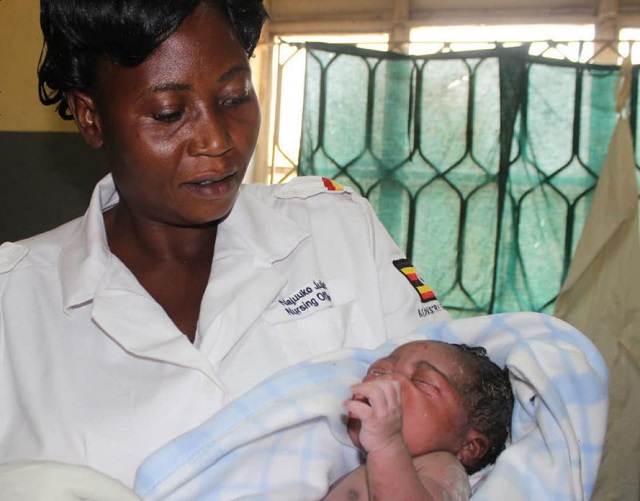
New report show challenges they face to prevent maternal and newborn deaths
Kampala, Uganda | PATRICIA AKANKWATSA | Majority of maternal and newborn deaths in Uganda are due to preventable causes that can be significantly reduced by access to midwifery care during pregnancy, at birth, and after birth, particularly the first 48 hours.
Midwives have the skills to recognise and provide the appropriate intervention or referral to prevent majority of maternal and newborn deaths as well as disability due to pregnancy complications such as obstetric fistula. However access to midwifery care in Uganda is constrained due to a number of factors. This has contributed to the unacceptably high maternal mortality of 368 deaths per 100,000 live births.
Uganda has about 70,167 nurses and midwives registered with the Uganda Nurses and Midwives Council.
According to the State of World’s Midwifery report 2021 by UNFPA; the United Nation’s sexual and reproductive health agency, the world is currently facing a shortage of 900,000 midwives, which represents a third of the required global midwifery workforce.
Agali Namugwere who has been a midwife for the past 11 years works at Kamwokya Christian Caring Centre says the biggest issue they face is under staffing. She says in the past 11 years she has worked at three hospitals and the story never changes.
She says they are only three midwives at the health centre.
“I work during day and the other two work at night on different days but it is hard sometimes. For example there are times when three mothers come at the same time and I am supposed to handle them at once,” she says.
“I end up calling the others when they are supposed to be resting and it is also the same with their turns,” she narrates.
Dr. Nehemiah Katusiime the Executive Director of Kawempe referral hospital says that they are also short of staff by 33%.
“We need 470 midwives but we have around 200 only,” he says.
Namugwere says the available midwives are poorly paid and that is why most of them opt to go abroad for greener pastures.
“We spend a lot of money in school only to paid Shs300,000 per month without an allowance even,” she says.
She also says that sometimes they do not have enough medical equipment which leads to increased deaths.
“Here at our health centre, we don’t have a theatre but sometimes labour gets complicated and the mother needs to be operated. That means she has to be referred to another hospital and I have to escort her which means there will be no midwife left to tend to others at the health centre. Because we work one at a time,” she adds.
Investing in midwifery
Dr. Natalia Kanem, UNFPA Executive Director says that the State of the World’s Midwifery report sounds the alarm that currently the world urgently needs 1.1 million more essential health workers to deliver sexual, reproductive, maternal, newborn and adolescent health care, and 80 per cent of these missing essential health workers are midwives.
A capable, well-trained midwife can have an enormous impact on childbearing women and their families – an impact often passed on from one generation to the next.
“At UNFPA, we have spent more than a decade strengthening education, enhancing working conditions and supporting leadership roles for the midwifery profession. We have seen that these efforts work, but they need greater investment,” she says.
“As a country with more than 70,000 registered nurses and midwives comprising 75% of the health workforce, we must challenge ourselves to invest more in our own nurses and midwives, empower, uplift and motivate, and recognise their contribution towards the Health Sector,” says Angellah Ilakut, the registrar Uganda Nurses and Midwives Council (UNMC)
“Investing in nurses and midwives is no longer a debatable topic but instead a call to action to ensure quality patient outcomes and the resilience of health systems,” she adds.
Dr. Katusiime says that wide implementation of the schemes of service for nurses and midwives for better wages is a priority.
“This will incentivise nurses and midwives through the provision of a conducive and enabling policy framework and environment that will see nurses and midwives perform to their full potential,” he says.
“The government must work towards increasing the health budget to cater for services such as training of midwives and other health workers, provision of personal protective gear, reasonable remuneration, and provision of all the necessary equipment in the facilities to enable them work better,” he adds.
In 2018, the Nursing Now campaign was launched to uplift the status of nursing and midwifery worldwide, with Uganda among the Pilot countries.
“As autonomous, primary care providers, midwives are continually overlooked and ignored. It’s time for governments to acknowledge the evidence surrounding the life-promoting, life-saving impact of midwife-led care, and take action on the World Midwifery report’s recommendations,” says Dr. Franka Cadée, President of the International Confederation of Midwives.
“ICM is committed to leveraging the strength of our global midwife community to carry forward these powerful findings and inspire country-level change. However, this work is not possible without commitment from decision makers and those with the resources to invest in midwives and the quality care they provide to birthing women,” she says.
Dr. Tedros Adhanom Ghebreyesus, WHO Director-General says that midwives play a vital role in reducing the risks of childbirth for women all over the world, but many have themselves been exposed to risk during the COVID-19 pandemic.
“We must learn the lessons the pandemic is teaching us, by implementing policies and making investments that deliver better support and protection for midwives and other health workers.
“This report provides the data and evidence to support WHO’s longstanding call to strengthen the midwifery workforce, which will deliver a triple dividend in contributing to better health, gender equality and inclusive economic growth,” he says.
****
 The Independent Uganda: You get the Truth we Pay the Price
The Independent Uganda: You get the Truth we Pay the Price



